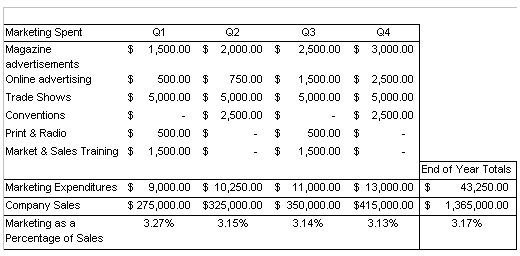How to Prepare a Marketing Budget for New & Existing Businesses
For some companies, coming up with a marketing budget can be an exercise in itself. The question for these companies becomes, “How to prepare a marketing budget?” It’s fine when a company has an established record, with years of experience to build upon, but what about the new company that’s just getting started? What are the steps to preparing a marketing budget for both new and existing businesses who’ve perhaps not yet adopted one?
We’ll review the essential steps involved in ensuring the marketing budget is clearly defined and measures results, and why it’s essential to track the performance of marketing plans to make adjustments in future budgets.
1. What Will the Marketing Budget be Based on?
Adopting a marketing budget must first start with an understanding of how the marketing budget itself will be put together. However, one must first start with an understanding of what to base the marketing budget on. It can be based on several sales calculations:
- Percentage of future or projected sales.
- Percentage of past sales.
- Percentage of current sales.
- Seasonality adjustments for spikes in demand for busier times of year.
An example of a seasonality marketing budget is one in which certain summer businesses determine their marketing budget in early March or April and enact those marketing plans in May. After deciding on what to base the budget on, you can then move to the next step on how to prepare a marketing budget.
2. How Will the Marketing Budget be Measured?
Without properly measuring the results, there is simply no way to measure success or failure, or to be able to determine what marketing initiative works better than others and produces a better ROI (Return on Investment). Marketing ROI simply refers to the outputs (in terms of additional customers & business) that results from a given input (the marketing initiative).
If a company spends $100.00 a month on a given marketing approach and produces 50 customers as a result, then the company must then measure the additional business brought in by those 50 new customers. How would this compare to a marketing initiative that cost $50.00 a month and brought in 30 additional new customers? Well, the only way to truly know for sure would be to determine the value of the business brought in by those 30 new customers at the $50.00 spent versus the value of value of business brought in by the 50 customers at $100 spent. Therefore, be sure to measure the results of your marketing approaches by tracking how many customers those plans bring in and how much business comes as a result.
3. Be Sure to Track Monthly or Quarterly Performance
When preparing a marketing budget, it’s the results from month to month, quarter to quarter or from year to year that help set the stage for either increasing or decreasing a given marketing budget expenditure. Tracking the performance of a marketing plan by quarter will allow companies to determine the net benefit of the marketing plan and track the marketing expenditure as a percentage of company sales.
4. Deciding What & Where to Spend
For companies that have existing budgets, it’s rather easy to determine the amount to spend relative to the marketing approach. However, it’s simply not the same for new businesses. So, where does this information come from? Well, in the case of new businesses, it really amounts to making some factual assertions. These factual assertions can come from industry sources that provide relevant information on a given market. This could come from trade magazines, industry newsletters or internet research.
Initial budgets always involve some aspect of guess work. However, mitigating that guess work is done by making factual assertions based on solid information. Initial marketing budgets aren’t perfect, but are improved over time. When deciding where to spend your advertising dollar, ask yourself the following questions on how best to reach your customers.
-
Are your customers the general consumer who’ll search for your business on the internet or see your advertisement in print?
-
Are your customers businesses that are more prevalent at industry trade shows, conferences and therefore more geared towards business to business marketing & sales approaches?
-
Are your customers a specific niche or age demographic that congregate at a given location or online social forums and websites?
Answering these questions will provide the basis for understanding how best to concentrate your marketing dollar. Understanding your target audience is as important as ensuring your marketing budget is properly prepared. In fact, one simply can’t succeed without the other.
5. Establishing the Budget Itself
In our example, we’ll base our marketing budget as a percentage of sales by quarter. In the attached budget we’ve summarized the total expenditures by quarter on magazine advertisements, online advertising, trade shows, conventions, print & radio as well as miscellaneous marketing & sales training. Each quarter’s marketing expenditures are summed up at the bottom of each quarter. The company’s sales for that quarter are just below, and below that is the marketing expenditure expressed as a percentage of sales. The calculation is done by taking total marketing expenditures and dividing it by the company’s sales for that quarter.
When companies look to answer that quintessential question of how to prepare a marketing budget, they must understand that part of the success of the marketing plan is to manage the budget’s expenditures and performance over time. In this sense, practice makes perfect.
Screenshot taken by Visionquest.
